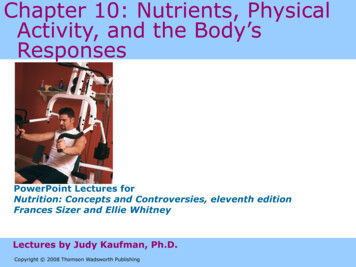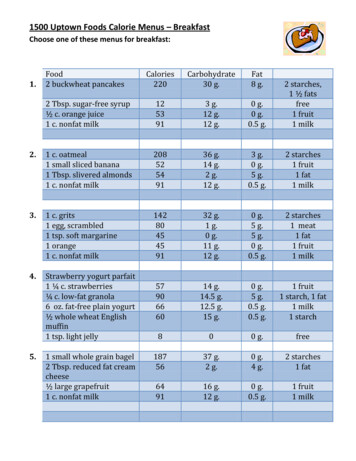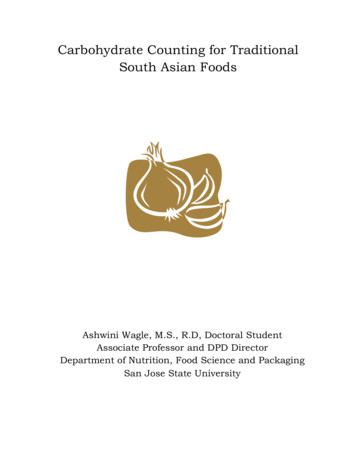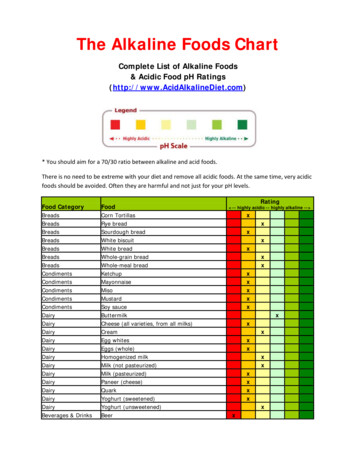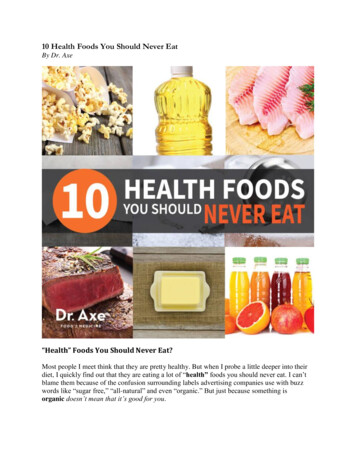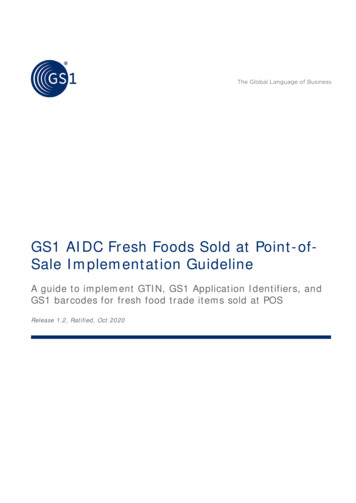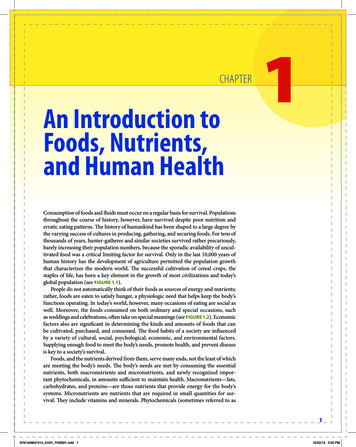
Transcription
CHAPTERAn Introduction toFoods, Nutrients,and Human Health1Consumption of foods and fluids must occur on a regular basis for survival. Populationsthroughout the course of history, however, have survived despite poor nutrition anderratic eating patterns. The history of humankind has been shaped to a large degree bythe varying success of cultures in producing, gathering, and securing foods. For tens ofthousands of years, hunter-gatherer and similar societies survived rather precariously,barely increasing their population numbers, because the sporadic availability of uncultivated food was a critical limiting factor for survival. Only in the last 10,000 years ofhuman history has the development of agriculture permitted the population growththat characterizes the modern world. The successful cultivation of cereal crops, thestaples of life, has been a key element in the growth of most civilizations and today’sglobal population (see FIGURE 1.1).People do not automatically think of their foods as sources of energy and nutrients;rather, foods are eaten to satisfy hunger, a physiologic need that helps keep the body’sfunctions operating. In today’s world, however, many occasions of eating are social aswell. Moreover, the foods consumed on both ordinary and special occasions, suchas weddings and celebrations, often take on special meanings (see FIGURE 1.2). Economicfactors also are significant in determining the kinds and amounts of foods that canbe cultivated, purchased, and consumed. The food habits of a society are influencedby a variety of cultural, social, psychological, economic, and environmental factors.Supplying enough food to meet the body’s needs, promote health, and prevent diseaseis key to a society’s survival.Foods, and the nutrients derived from them, serve many ends, not the least of whichare meeting the body’s needs. The body’s needs are met by consuming the essentialnutrients, both macronutrients and micronutrients, and newly recognized important phytochemicals, in amounts sufficient to maintain health. Macronutrients—fats,carbohydrates, and proteins—are those nutrients that provide energy for the body’ssystems. Micronutrients are nutrients that are required in small quantities for survival. They include vitamins and minerals. Phytochemicals (sometimes referred to as19781449647414 CH01 PASS01.indd 110/22/13 2:55 PM
2CHAPTER 1An Introduction to Foods, Nutrients, and Human Healthnutrition The branch of sciencedealing with foods, nutrientcomposition, eating habits,nutritional status, and healthand diseases of individuals andpopulations.nutrient Essential or non-essentialmolecules or minerals derived fromfoods that are used by cells in thebody to complete diverse functions.non-nutrient Food molecules thatare not considered nutrients becausethey are not essential for cellular ortissue needs. However, they maybe important for other aspects ofhuman health; for example, dietaryfibers and many phytomolecules mayprotect against cancer and otherchronic diseases.macronutrient Class of nutrientsthat generate energy (carbohydrates,fats, proteins) and provide nitrogen(N) and amino acids (protein).Sometimes other molecules, such asdietary fiber and water, are includedin this class because they areconsumed in large amounts.9781449647414 CH01 PASS01.indd 2 Levent Konuk/ShutterStock, Inc. Robert Harding Picture Library Ltd/AlamyFIGURE 1.1 Emergence of Agriculture. The development ofagriculture approximately 10,000 year ago permitted the increasesin human population growth that characterize the modern world.FIGURE 1.2 Ample Food Availability. Advances in agricultureand food processing have produced an abundance of food in manyparts of the world. In many societies, food plays a key role in thecelebration of special occasions.phytomolecules) are plant-derived molecules that are increasingly being noted for theirrole in maintaining human health.Nutrition, as a field of study, represents a broad area of knowledge encompassinginformation from the basic sciences, behavioral sciences, and other fields of investigation. Because of new findings from current research investigations, nutrition is evolvingquite rapidly, but putting the new information into clinical practice or incorporatingit into public policy takes time, often decades. New research findings are not rapidlyimplemented into clinical practice, even though the findings may be encouraging. Thischapter examines several important nutrition topics in order to lay the foundation foradditional study.Food and NutrientsThe body’s needs for macronutrients, micronutrients, and water relate to metabolicrequirements and the role these nutrients play in forming biological compounds. Otherdietary components that impact health are alcohol, dietary fiber, and phytochemicals.Table 1.1 lists the nutrients and non-nutrients that are required across the humanlife cycle. As you learn more about nutrition, keep in mind the increasingly importantroles of non-nutrient plant molecules that promote health.MacronutrientsThe macronutrients—carbohydrates, fats, and proteins—exist mainly as polymersor long chains. They provide energy, expressed as kilocalories (kcal), plus a few otherunique structures required in human tissue. Fats and carbohydrates provide the bulkof energy, whereas proteins provide a smaller amount. The primary energy-providingmacronutrients—carbohydrates and fats derived from plants and animals—provideapproximately 85% of energy (expressed as kilocalories or kilojoules) intake by humankind in the Western world and perhaps 90% or more in other parts of the world. Proteinprovides nearly all of the remaining energy consumed on a daily basis. In addition to10/22/13 2:55 PM
3Food and NutrientsTABLE 1.1Required Nutrients and ietary cellulosesOthersMicronutrientsVitaminsWater solubleFat solubleMineralsMacromineralsMicromineralsSelect vonoidsMonoterpenes* Note that there are actually thousands of phytochemicals found in nature. Some of the moreimportant classes of phytochemicals are listed here.their constituent amino acids, proteins are essential because they provide nitrogen thatis needed for the synthesis of deoxyribonucleic acid (DNA) and related molecules.MicronutrientsThe micronutrients are represented by vitamins and minerals, which have specificroles in metabolism. The micronutrients are needed in small quantities each day.Vitamins are categorized as water soluble or fat soluble. The distinction between thesetwo types of vitamins lies in their solubility in water or in organic solvents, including fats and oils. Vitamins are needed for a large number of cellular and extracellularchemical reactions. For example, vitamins A and D are fat-soluble vitamins. Vitamin Aplays a role in growth and vision; vitamin D, obtained from either the diet or synthesized when exposed to the sun, has an important role in calcium metabolism.Minerals are used in chemical reactions as well as in structural components of cellsand tissues. For example, calcium is a critical component of hard tissues such as boneand teeth and plays a variety of other roles. Macrominerals are needed in daily amountsgreater than 100 milligrams per day. Microminerals are needed in amounts of less than100 milligrams per day. Water often is considered with minerals.EnergyFood energy is measured in kilocalories, often simply referred to as calories or kcals.This energy is derived from the breakage of hydrocarbon bonds, often written as C-Hbonds, in macronutrients (i.e., carbohydrates, fats, proteins). Energy is not a nutrientper se; rather, energy is derived from macronutrients. Therefore, when energy is classified with the macronutrients, it is correctly called a dietary variable rather than anutrient.9781449647414 CH01 PASS01.indd 3“The body’s needs formacronutrients, micronutrients,and water relate to metabolicrequirements and the rolethese nutrients play in formingbiological compounds.”micronutrient Class of nutrientsthat includes vitamins and minerals;nutrients consumed in small amountseach day.vitamin An essential organicmicronutrient needed in the dietin small amounts; consists of bothwater-soluble and fat-solublevitamins.mineral Elements in the earth’ssurface that are needed by thehuman body, such as calcium andiron.energy (calorie) A physical unitof energy that is derived fromfood macronutrients and alcohol;1 kilocalorie is the amount of heatrequired to raise the temperature ofa gram of water 1 C. Energy alsocan expressed in joules, where1 kilocalorie is equal to 4.2 kilojoules.10/22/13 2:55 PM
4CHAPTER 1“Energy is not a nutrientper se; rather, energy is derivedfrom macronutrients.”An Introduction to Foods, Nutrients, and Human HealthThe recommended energy contribution of macronutrients to the diet by percentagetypically breaks down to approximately 50% or more for carbohydrates, 35% or lessfor fats, and 15% or more for proteins. The percentage of energy from alcohol variessubstantially, but the percentage of those who consume alcohol on a regular basis maybe as high as 5%.Atwater EquivalentsThe Atwater equivalents system is used to provide a rough estimate of the available energy in foods. Atwater equivalents are estimates of the amount of energy ineach of the macronutrients and alcohol (ethanol). These estimates are based on theenergy in kilocalories generated when the hydrocarbon backbones of the molecules arecompletely oxidized to carbon dioxide and water. The Atwater system uses the averagevalues of 4 kilocalories per gram for protein, 4 kilocalories per gram for carbohydrate,and 9 kilocalories per gram for fat. Alcohol is calculated at 7 kilocalories per gram.The Problem of Too Much EnergyThe greatest problem in the American diet today is the inability to maintain a healthyenergy balance, which is the balance between energy intake and energy expenditure.Americans consume too much energy (calories) via the excessive intake of foods andbeverages. Although average adult energy intake has decreased slightly since 2000, ourenergy expenditure for work and other activities has decreased even more! This energyimbalance leads to storage of excess calories in fat stores (adipose tissue deposits) scattered throughout the body as well as weight gain. Obesity, which reached epidemicproportions among American adults and children in the 1990s, results from the overconsumption of food energy coupled with a sedentary lifestyle. Although jogging and othersports activities have become popular with some health-conscious individuals, it has hadrelatively little effect on the U.S. population as a whole because of the high percentage ofinactive individuals and because of the great amount of physical activity needed to balance energy intake, especially from excessive calories in the diet. This latter point—balancing energy intake with expenditure—is not readily embraced by most people.Atwater equivalent Theenergy equivalent per gram ofmacronutrient or alcohol (ethanol):1 gram of carbohydrate yields4 kilocalories, 1 gram of fat yields9 kilocalories, 1 gram of proteinyields 4 kilocalories, and 1 gram ofalcohol (pure or 200 proof) yields7 kilocalories.energy balance The balancebetween energy intake and energyexpenditure. Energy imbalancerepresents either higher intake thanexpenditure or the reverse. Positive( ) energy balance results in weightgain. Negative (–) energy balanceresults in weight loss.phytochemical (phytomolecule)Non-nutrient molecules made byplants and found in diverse fruits,vegetables, grains, nuts, and seeds.Many of these molecules, especiallyantioxidants, are thought to protectagainst cancer.9781449647414 CH01 PASS01.indd 4Non-Nutrient PhytochemicalsNo new nutrients have been discovered since the mid-twentieth century, but scientistscontinue to identify new, beneficial, non-nutrient phytochemicals. Because these molecules are derived from plants, they are logically referred to as phytochemicals orphytomolecules. Phytochemicals are found only in plant-based foods. Plants producephytochemicals to serve a variety of diverse functions. For example, fiber, which inhuman nutrition is referred to as dietary fiber, serves as a structural component of plantcell walls and provides rigidity to plant tissues.Thousands of different of phytochemicals exist, each with a unique chemical structure and purpose. Many of these molecules are polyphenols. Some of these moleculeshave rather simple structures, such as phytate, whereas others, such as polyphenols, havemore complex structures (see FIGURE 1.3).Phytochemicals do not provide energy (i.e., calories) to humans, but they do playimportant roles in maintaining human health (see FIGURE 1.4). Returning to our example of fiber, in humans, fiber molecules play a role in maintaining the health of the gastrointestinal tract. Other phytochemicals act as antioxidants that protect cells againstfree radicals or highly reactive chemicals produced as a result of cell metabolic pathways(see FOCUS BOX 1.1). Because phytochemicals are made by plants to meet their ownneeds, not those of humankind, the assumption that all phytochemicals are beneficialto human health is incorrect. In fact, some phytochemicals are actually toxic and mustbe avoided.10/22/13 2:55 PM
5Food and Nutrients–OOO–O PO –OO O POHOO P(a)O P–OOO–O–O–OPOHOOH–O POOHOOHorO–OHOHHO(b)O(c)FIGURE 1.3 Phytochemicals. The molecular structures of phytochemicals vary. The molecular structure of three phytochemicals areshown: (a) phytate, (b) phytosterol, and (c) polyphenol.F OCUS1.1Fre e R ad ic alsWhat are free radicals? Why should people beconcerned about them? Free radicals are atoms thathave an unpaired electron. Atoms with unpaired electronscan bond easily with other atoms with unpaired electrons,which means they are highly reactive! Many types of radicals are possible, but those of most concern in the humanbody are derived from oxygen. Collectively, the oxygenradicals are called reactive oxygen species. Damage tothe body’s cells and tissues occur when free radicals bond Africa Studio/ShutterStock, Inc. Elena Schweitzer/ShutterStock, Inc. (b) Serg64/ShutterStock, Inc. Multiart/ShutterStock, Inc.(a)with other molecules or atoms. In particular, free radicalscan do a lot of damage if they interact with cellular DNA orthe cell membrane. However, the body has a way to fightthe damage from reactive oxygen species: antioxidants.Antioxidants are molecules that can inactivate or neutralizefree radicals, thus preventing them from causing cellulardamage. Many of the phytochemicals in plants also act asantioxidants.(c)(d)FIGURE 1.4 Food as a Source of Energy and Phytochemicals. Food provides energy due to the breakage ofchemical bonds in (a) carbohydrates, (b) proteins, and (c) fats. Phytochemicals found in fruits and vegetables (d)are important to human health, but they do not supply energy.9781449647414 CH01 PASS01.indd 5free radical A highly reactivechemical species (of very short life)—typically oxygen atoms containinga free electron—that combine witha carbon atom of an unsaturatedfatty acid (at the double bonds)or of other molecules, includingproteins and DNA. This can resultin an alteration at the point of theunsaturation as well as damage toDNA and mutations.10/22/13 2:55 PM
6CHAPTER 1An Introduction to Foods, Nutrients, and Human HealthGuidelines and Recommendations“Healthy dietary patterns provide all of the essential nutrients, energy, and phytochemicals. For good health, the diet should include mostly nutrient-dense or nutrient-richfoods because they contain many micronutrients in addition to modest amounts ofmacronutrients for energy and protein. In contrast, energy-dense or calorie-densefoods are generally not recommended because they contain too much energy and toofew micronutrients. In addition, diets that contain the amount of calories needed forgood health help maintain a healthy body weight.But what actually determines what people eat? The three major determinants offood intake are availability of foods, purchasing power (money or barter), and socialand cultural values placed on specific foods (see FIGURE 1.5 and FOCUS BOX 1.2). Thefirst two factors are more important in developing countries, whereas the third becomesmore important in developed countries where purchasing power and a wide availability of foods permit the selection of specific foods. (In these countries, food marketingand advertising may also contribute substantially to the consumption of specific foodproducts, especially processed items such as chips, dips, soft drinks, and conveniencefoods.) Food availability is highly determined by one’s geographic location due toproduction, distribution and cultivation being dependent on an area’s climate, infrastructure and economy. Social and cultural values have historically been majorfactors contributing to food intake, and they remain so in many low-income nations,but they have become less influential in more affluent nations where markets have mostfoods available almost the entire year for those who can afford them.Information, and even misinformation, on the nutritional quality of foods can beattained from the food composition table. Though only in the last century hasthis been recognized as a standard for good health, it is gradually becoming a fourthdeterminant of food intake. In general, a growing interest in the role of food in healthand the wide prevalence of nutritional labeling on food packaging has fostered thisnew determinant of food intake. Foods supply the nutrient requirements and nonnutrient phytochemicals that are critical for both health promotion and disease prevention. Governments around the world, in particular the United States, offer dietaryguidelines and recommendations to improve the health of their populations.The three majordeterminants of food intake areavailability of foods, purchasingpower (money or barter), andsocial and cultural values placedon specific foods.”determinants of food intake Themajor factors that drive people tochoose the foods that they consume:emotions, social and cultural factors,and food availability.social and cultural values Valuesapplied to foods by a group,culture, or society; in the UnitedStates, societal food values exist,but they have been greatly affectedby the marketing of a tremendousarray of processed foods. A majordeterminant of food habits.food composition table A tableor database that contains dataon the nutrient content of foods.Such tables are published by U.S.government agencies, such as theUSDA, and in other sources, suchas McCance and Widdowson’s TheComposition of Foods.9781449647414 CH01 PASS01.indd 6(a) Jacob Kearns/ShutterStock, Inc. ValeStock/ShutterStock, Inc.food availability The availabilityof food or foods in a particulargeographic region becauseof production, distribution, orcultivation of the foods for humanconsumption. It is one of thebasic determinants of food intake,particularly in poorer nations.(b)FIGURE 1.5 Food Availability. In developed countries, a wide variety of foods are available in supermarkets (a) andfarmers’ markets (b), offering consumers many options for both healthful and unhealthful eating.10/22/13 2:55 PM
7Guidelines and RecommendationsF OCUS1.2M o n ey and Fo o dAn old quote states that “Money makes the world goround”; in some cases money also can determine whether a person is able to maintain a healthful diet. Purchasingpower, or money, is a major determinant of food intake.In some poor nations, food choices may be limited due tolimited food availability and inadequate purchasing power.For example, people who do not have money or who areliving in a war zone may find it difficult to obtain a variety ofnutrient-rich foods, or even any food. Typically, people withlimited financial resources have less healthy eating patternsbecause their limited funds do not permit them to purchasemore costly meats, dairy foods, fruits, and vegetables. Theirdiets consist primarily of foods derived from low-cost grains.Over time, such a diet will result in disorders resulting frominadequate intake of certain macronutrients and micronutrients. To compound the problem, in many underdevelopedcountries the poor must also contend with polluted waterand unsanitary living conditions, which can exacerbatediseases resulting from malnutrition.Money does not have as strong an influence on thedietary habits of populations in middle-income countriesand in developed nations such as the United States andCanada. In the United States and other rich nations, a lowerpercentage of family income is spent on food by the vastmajority of the population. Therefore, food habits are basedless on purchasing power than on nutritional awareness,convenience, and cultural and family traditions. In theUnited States, in particular, poor eating habits are oftenassociated with lower incomes and lower education levels.Lower-income consumers often exhibit relatively poor foodhabits. Middle- and upper-income consumers tend to consume more luxury items, more variety, more conveniencefoods, and more low-fat alternative foods. Because of theirgenerally poor food habits, lower-income individuals havea substantially greater burden of obesity, hypertension,diabetes, and disorders associated with nutritional excessesand inadequacies. One solution is to provide better education on diet and exercise for low-income Americans. Wesley Bocxe/Science Source Alexander.Yakovlev/ShutterStock, Inc. OlegD/ShutterStock, Inc.purchasing power (money) Theeconomic capability of a family (orindividual) to purchase items for afamily unit. A major determinant offood habits.9781449647414 CH01 PASS01.indd 710/22/13 2:55 PM
8CHAPTER 1An Introduction to Foods, Nutrients, and Human HealthDietary Guidelines for AmericansThe Dietary Guidelines for Americans, a report jointly produced by the U.S.Department of Agriculture (USDA) and Department of Health and Human Services(DHHS), provides the U.S. population with general recommendations for food consumption that will result in good health and will reduce the burden of diet-relatedchronic diseases. The Guidelines emphasize the benefits of eating a variety of foods;consuming less sugar and salt; eating more fruits and vegetables and low-fat dairyproducts; and balancing energy intake with expenditure. The Guidelines also discourage the consumption of foods low in complex carbohydrates and high in saturated fats.A current selection from the Dietary Guidelines for Americans is provided in Table 1.2.Note that the Guidelines provides an up-to-date summary of what foods should be consumed, but not the amounts or numbers of servings.MyPlateDietary Guidelines forAmericans Document prepared bya committee representing both theUSDA and the Department of Healthand Human Services that providesguidelines that Americans shouldfollow to ensure a healthy diet. Theguidelines stress reductions in theconsumption of fat, cholesterol,and sodium; increased consumptionof complex carbohydrates, dietaryfiber, and fruits and vegetables;maintenance of a desirable bodyweight; and limited alcoholconsumption. The guidelines areupdated every 5 years.MyPlate The food guidance systemdeveloped by the USDA for the U.S.population. It includes five foodgroups: grains, proteins, vegetables,fruits, and dairy. It uses an icon thatshows a plate and drink to providea pictorial display of the how muchof a meal should be representedby each food group. It provides anentire website with menus, a foodcomposition table, and many otherdietary tools.MyPyramid An update on theearlier U.S. food guide pyramid thatwas replaced by MyPlate. It stressedactivity and moderation along witha proper mix of food groups in one’sdiet. MyPyramid was designed toeducate consumers about a lifestyleconsistent with the 2005 DietaryGuidelines for Americans.9781449647414 CH01 PASS01.indd 8The plant and animal foods commonly consumed in the United States and other developed countries are clustered into five general groups—grains, vegetables, fruits, meatsand proteins, and dairy foods—as well as an additional miscellaneous group. Thegroups contain related foods and their products resulting from minimal processing ofthe raw foods. Food pyramids and food guides utilize these groups for making recommendations of the number of servings from each group on a daily basis. The USDA’sMyPlate (see ChooseMyPlate.gov) is an example of such a food guidance system (seeFIGURE 1.6). With MyPlate, food groups are represented as proportions on a plate relative to the recommended daily amounts. The plate shown in Figure 1.4 is the mostrecent visual diagram prepared by the USDA to convey important dietary informationto the U.S. population. Note that MyPlate and the older MyPyramid (see FIGURE 1.7)replace the old USDA food pyramid.TABLE 1.2Examples from the Dietary Guidelines for Americans Prevent and/or reduce overweight and obesity through improved eating andphysical activity behaviors.Reduce daily sodium intake to less than 2,300 milligrams (mg) and further reduceintake to 1,500 mg among persons who are 51 and older and those of any age whoare African American or have hypertension, diabetes, or chronic kidney disease.Consume less than 10% of calories from saturated fatty acids by replacing themwith monounsaturated and polyunsaturated fatty acids.Reduce the intake of calories from solid fats and added sugars.Limit the consumption of foods that contain refined grains, especially refined grainfoods that contain solid fats, added sugars, and sodium.Increase vegetable and fruit intake.Eat a variety of vegetables, especially dark-green and red and orange vegetablesand beans and peas.Increase intake of fat-free or low-fat milk and milk products, such as milk, yogurt,cheese, or fortified soy beverages.Data from U.S. Department of Agriculture and U.S. Department of Health and Human Services.Dietary Guidelines for Americans 2010. 7th ed. Washington, DC: U.S. Government Printing Office,2010.10/22/13 2:55 PM
9Guidelines and RecommendationsFIGURE 1.6 MyPlate. Released in 2011, MyPlate is a visual guide that helps consumers implement theprinciples of the Dietary Guidelines for Americans, 2010 and other nutritional standards.Courtesy of the U.S. Department of Agriculture.Dietary Reference IntakesDietary needs are typically met by the consumption of a variety of foods in a balancedmanner over a period of approximately a week, not necessarily every day. Nutrients,energy, and phytochemicals are needed for good health throughout the life cycle, butnutritional needs are typically higher during childhood and adolescence as well as pregnancy and lactation. Growth and development of the body and its organs early in liferepresent the first major challenges for obtaining sufficient amounts of all the essentialnutrients. Maintenance and active functioning of the fully grown adult body requirethese same nutrients. Finally, nutrient requirements later in life typically decline as leanbody mass (i.e., the mass of the body minus body fat) also decline. Foods provide all thenutrients, but all foods are not equal in their nutrient composition. Thus, it is importantto choose a variety of foods each day to ensure that all the essential nutrients are consumed in a 24-hour period. Eating a variety of foods should supply the macronutrientsand micronutrients needed by our cells and tissues at all stages of the life cycle.Recommendations for the intake of different nutrients across the life cycle, includingpregnancy and lactation, have been established for the populations of the United Statesand Canada. These recommendations are known as Dietary Reference Intakes(DRIs) (see FIGURE 1.8). The DRIs represent a set of recommended intakes for nutrients, energy, water, and dietary fiber that support health and prevent disease across thevarious stages of the life cycle, from birth to old age and during pregnancy and lactation. The DRIs serve as the standards for specific dietary recommendations as well asthe upper limits of safe intakes. Four new categories have been added to the terminology of the DRIs in an effort to broaden understandings of how the DRIs are established.The four new categories and their acronyms are: Estimated Average Requirement(EAR), Recommended Dietary Allowance (RDA), Adequate Intake (AI), andTolerable Upper Limit (UL) of Safety (safe intake). Intakes of nutrients beyondtheir UL are not considered safe.9781449647414 CH01 PASS01.indd 9Dietary Reference Intake(DRIs) Recommended intakes ofnutrients that are presented in aseries of books from the Institute ofMedicine. Each nutrient either hasa Recommended Dietary Allowance(RDA) or an Adequate Intake (AI),depending on the availability ofinformation upon which to make arecommendation.Estimated Average Requirement(EAR) The amount of intake of anutrient needed by the averageindividual to maintain goodhealth. If a nutrient has an EAR, itsRecommended Dietary Allowance(RDA) is based on the mean (average)and 2 standard deviations abovethe mean.Recommended Dietary Allowance(RDA) Recommended intakes ofspecific nutrients; generally theEstimated Average Requirement(EAR) plus an additional safety factorspecific for each nutrient. Agegender groups are considered fordifferent RDAs, as are women whoare pregnant or lactating.Adequate Intake (AI) A designationunder the Dietary Reference Intakes(DRIs) of recommended intakes forseveral nutrients that do not havean Estimated Average Requirement(EAR). Usually used with nutrientswhere not enough informationis available to set a more exactrequirement (RDA).Tolerable Upper Limit of Safety(UL) The safe upper limit of intakeof a nutrient from foods andsupplements; determined whenestablishing the Dietary ReferenceIntake (DRI) of a nutrient.10/22/13 2:55 PM
10CHAPTER 1An Introduction to Foods, Nutrients, and Human HealthFIGU
e body’s needs for macronutrients, micronutrients, and water relate to metabolic requirements and the role these nutrients play in forming biological compounds. Other dietary components that impact health are alcohol, dietary ber, and phytochemicals. Table 1.1 lists the nutrientsand non-nutrients that a
